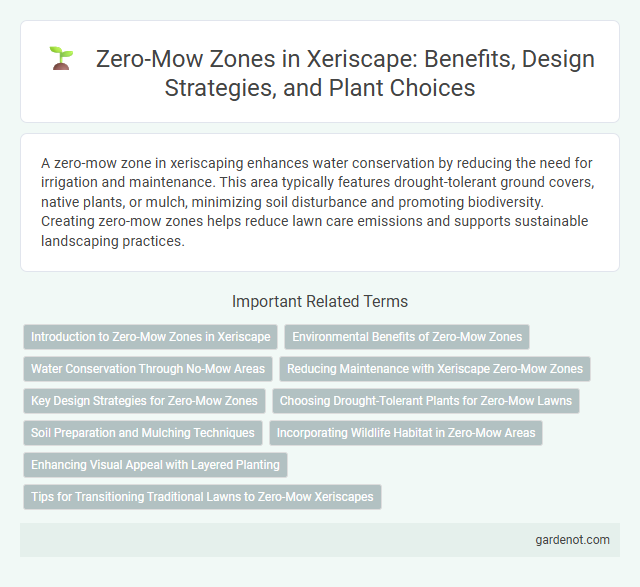A zero-mow zone in xeriscaping enhances water conservation by reducing the need for irrigation and maintenance. This area typically features drought-tolerant ground covers, native plants, or mulch, minimizing soil disturbance and promoting biodiversity. Creating zero-mow zones helps reduce lawn care emissions and supports sustainable landscaping practices.
Introduction to Zero-Mow Zones in Xeriscape
Zero-mow zones in xeriscape landscaping conserve water and reduce maintenance by allowing native plants and drought-tolerant grasses to grow freely without mowing. These areas enhance biodiversity, improve soil health, and create natural habitats for pollinators, promoting ecological balance. Implementing zero-mow zones significantly lowers water usage and carbon emissions compared to traditional manicured lawns.
Environmental Benefits of Zero-Mow Zones
Zero-mow zones significantly reduce water consumption by promoting drought-resistant native plants, which thrive with minimal irrigation. These areas enhance biodiversity by providing habitats for pollinators, birds, and beneficial insects, supporting local ecosystems. By eliminating frequent mowing, zero-mow zones decrease fossil fuel emissions and reduce soil compaction, improving carbon sequestration and overall soil health.
Water Conservation Through No-Mow Areas
Zero-mow zones significantly enhance water conservation by reducing irrigation demands commonly associated with traditional lawns. These no-mow areas use drought-tolerant native plants and mulch, which minimize soil evaporation and improve moisture retention. Implementing zero-mow zones in xeriscape landscapes effectively decreases water use while promoting sustainable, low-maintenance outdoor spaces.
Reducing Maintenance with Xeriscape Zero-Mow Zones
Xeriscape zero-mow zones significantly reduce landscape maintenance by eliminating the need for regular mowing, thereby saving time and reducing fuel consumption. Native drought-tolerant plants thrive in these areas, improving water conservation while minimizing soil erosion. Establishing zero-mow zones enhances biodiversity and lowers overall lawn care costs, making xeriscaping a sustainable landscaping choice.
Key Design Strategies for Zero-Mow Zones
Zero-mow zones in xeriscaping prioritize drought-tolerant native plants and deep-rooted grasses that require minimal irrigation and no mowing, promoting water conservation and soil health. Strategic placement involves grouping plants by water needs and using mulches or permeable ground cover to reduce evaporation and suppress weeds. Designing these areas with natural contours enhances stormwater absorption, reduces runoff, and creates sustainable, low-maintenance landscapes.
Choosing Drought-Tolerant Plants for Zero-Mow Lawns
Zero-mow zones thrive by incorporating drought-tolerant plants such as blue grama grass, buffalo grass, and sedum, which require minimal watering and mowing. Selecting native and adapted species enhances soil retention and reduces water usage, crucial for sustainable xeriscape lawns. These plants create resilient, low-maintenance landscapes that support biodiversity while conserving water resources.
Soil Preparation and Mulching Techniques
Proper soil preparation in zero-mow zones enhances water retention and nutrient availability, crucial for xeriscape success. Incorporating organic matter and loosening compacted soil improves root penetration and moisture absorption. Applying a thick layer of mulch reduces evaporation, suppresses weeds, and stabilizes soil temperature, promoting sustainable, low-maintenance landscapes.
Incorporating Wildlife Habitat in Zero-Mow Areas
Zero-mow zones in xeriscape gardens create essential habitats for local wildlife, providing shelter and food sources while minimizing lawn maintenance. Native plants and natural ground cover in these areas support pollinators such as bees and butterflies, enhancing biodiversity. Designing zero-mow zones with wildlife-friendly features improves ecological balance and promotes sustainable landscaping practices.
Enhancing Visual Appeal with Layered Planting
Zero-mow zones in xeriscape gardens enhance visual appeal by incorporating layered planting with varied heights, textures, and colors that mimic natural landscapes. Utilizing drought-tolerant grasses, groundcovers, and native perennials creates a dynamic, maintenance-free area that provides habitat for pollinators and reduces water use. Strategic layering not only adds depth and interest but also supports sustainable, eco-friendly garden design.
Tips for Transitioning Traditional Lawns to Zero-Mow Xeriscapes
Transitioning traditional lawns to zero-mow xeriscapes involves selecting drought-tolerant grasses like Buffalo grass or native sedges that require minimal watering and no mowing. Gradually reduce irrigation and mowing frequency to allow native plants and ground covers to establish a natural, low-maintenance appearance. Incorporating mulch and permeable hardscapes further conserves water and promotes soil health in zero-mow landscape designs.
Zero-mow zone Infographic

 gardenot.com
gardenot.com